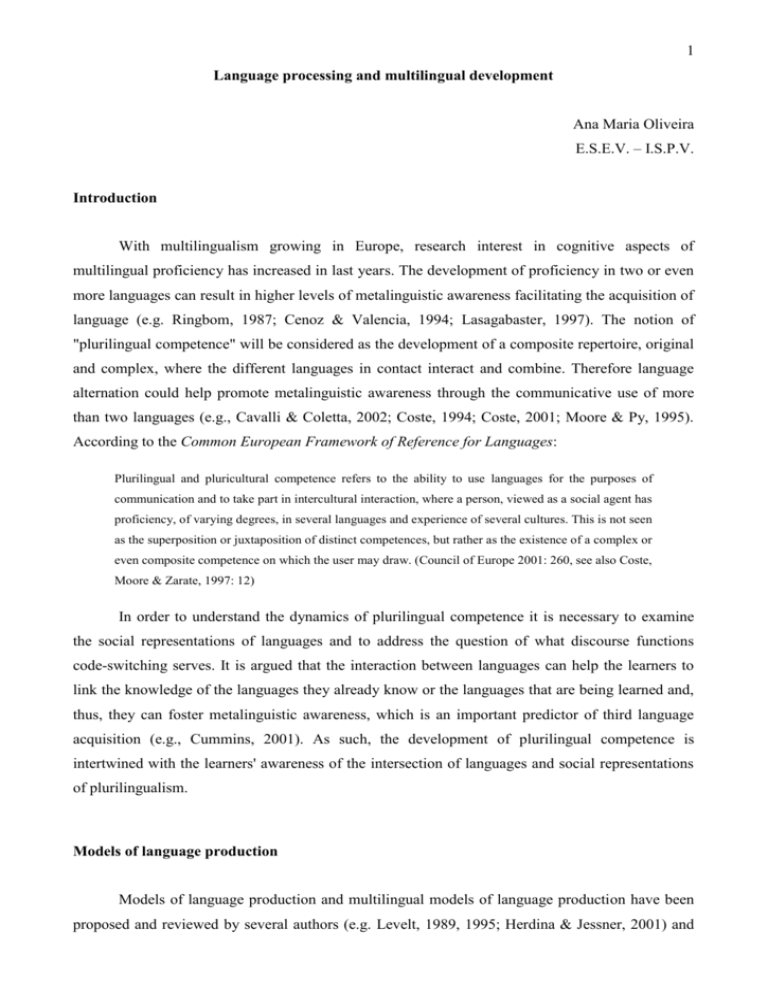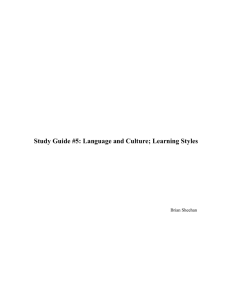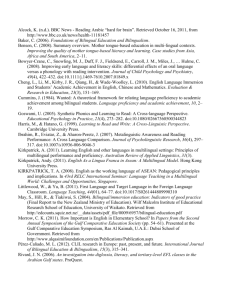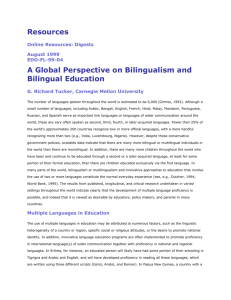Language processing and multilingual development
advertisement

1
Language processing and multilingual development
Ana Maria Oliveira
E.S.E.V. – I.S.P.V.
Introduction
With multilingualism growing in Europe, research interest in cognitive aspects of
multilingual proficiency has increased in last years. The development of proficiency in two or even
more languages can result in higher levels of metalinguistic awareness facilitating the acquisition of
language (e.g. Ringbom, 1987; Cenoz & Valencia, 1994; Lasagabaster, 1997). The notion of
"plurilingual competence" will be considered as the development of a composite repertoire, original
and complex, where the different languages in contact interact and combine. Therefore language
alternation could help promote metalinguistic awareness through the communicative use of more
than two languages (e.g., Cavalli & Coletta, 2002; Coste, 1994; Coste, 2001; Moore & Py, 1995).
According to the Common European Framework of Reference for Languages:
Plurilingual and pluricultural competence refers to the ability to use languages for the purposes of
communication and to take part in intercultural interaction, where a person, viewed as a social agent has
proficiency, of varying degrees, in several languages and experience of several cultures. This is not seen
as the superposition or juxtaposition of distinct competences, but rather as the existence of a complex or
even composite competence on which the user may draw. (Council of Europe 2001: 260, see also Coste,
Moore & Zarate, 1997: 12)
In order to understand the dynamics of plurilingual competence it is necessary to examine
the social representations of languages and to address the question of what discourse functions
code-switching serves. It is argued that the interaction between languages can help the learners to
link the knowledge of the languages they already know or the languages that are being learned and,
thus, they can foster metalinguistic awareness, which is an important predictor of third language
acquisition (e.g., Cummins, 2001). As such, the development of plurilingual competence is
intertwined with the learners' awareness of the intersection of languages and social representations
of plurilingualism.
Models of language production
Models of language production and multilingual models of language production have been
proposed and reviewed by several authors (e.g. Levelt, 1989, 1995; Herdina & Jessner, 2001) and
2
show that knowing two languages is the normal condition of mankind rather than an exception. It
attempts to integrate independent, automatic modules into a complete ‘speaking’ system. The
multilingual model of language production theory differs from other theories of bilinguals which
only involve the lexicon (e.g., Kroll & de Groot, 1997; Green, 1998). It outlines seven requirements
that any model of production has to meet. Some of them have been chosen to illustrate multilingual
language processing. In the multi-competence requirement, multilingualism is the default case, not
monolingualism. An average human being uses and knows another language. If linguistics is
concerned with what the average person knows about language rather than with what the ideal
person knows, it has to start by assuming the speaker knows more than one language, to a greater or
lesser extent. As Stenson (1990) puts it, 'Any grammatical theory that purports to account for
human linguistic competence must also be able to account for bilingual competence and the
associated performance.'
The second requirement, the multi-competence cognitive requirement, proposes that
speakers of different languages have different cognitions. Most models of language production see
the process as starting from the speaker's cognitive knowledge — the set of concepts which
underpins everything they say. It is the Levelt’s notion of 'conceptualisation' (1989): the speaker
has a speech impulse that causes the activation of concepts and their incorporation into a
conceptual message. It is assumed that 'cognition' stores these concepts. The multilingual model of
language production questions whether cognition is in fact separate from language or whether
cognition differs from speakers of one language to those of another. Thus it is important to
understand to what extent the language we speak shapes the way we see the world. We all have a
universal idea of saltiness in things that we taste. O’Mahoney and Muhiudeen (1977) tested the
ability of speakers of Bahasa (Malaysia) and English to distinguish solutions with different
amounts of salt. Malaysians were able to make much finer distinctions than English speakers.
Bahasa speakers recognise far more degrees of saltiness than English. So has the speaker's
conceptual world of taste been influenced by their language? Or has their language been adapted to
suit the flavours of their cuisine? In language awareness, while there may be universal functions,
particular languages did not employ all of them. Cook (2000) exemplifies it with the ritual at the
beginning of a meal called 'appetite-wishing', in German 'Mahlzeit' or 'Guten Appetit', in French
'Bon appetit', in Italian 'Bon appetito'. In English, an expression like 'Enjoy' had to be invented,
perhaps due to the cognitive aspects of food reflected in English cuisine.
Again, the area of language functions can be divided into universal elements arising from
our common human experience and particular elements due to the cultures we have encountered.
Their way of thinking is complemented by the structures of their language. Although language and
thought may be reciprocally influenced, it is assumed that speakers of different languages have
different concepts.
3
Levelt calls the product of conceptualisation the 'pre-verbal message' (Levelt, 1989) and
'lexical concept' (Levelt, Roelofs & Meyer, 1999); these labels already incorporate language
elements and so undermine the generality of the models by making the conceptualisation stage
specific to a single language. The lexical items stored in the multilingual mental lexicon not only
specify the meanings of words but also contain language-specific semantic, pragmatic syntactic,
morphological and phonological information about them. Thus, the multilingual mental lexicon is
defined as the multilingual internal representation of language-specific knowledge about the surface
forms. In a study presented by Wei (2003) with adult learners with Chinese as their first language,
English as their second language and German as their third language, and with Japanese as their
first language, English as their second language and Chinese as their third language, the research
findings provide empirical evidence that the activation of second language lemmas is the major
source of interlanguage transfer in target language lexical. A second language has different
language-specific concepts from a first language.
So, as far as social perceptions are concerned, a more radical possibility can be developed
from the theory of cognition put forward by Tomasello (2000). This treats language as arising from
the uniquely human ability to see the point of view of others, already seen in babies' abilities to
follow people's gaze. The second requirement is then that speakers of different languages have
different cognitions. The conceptualisation stage of the production process is not independent of
language but already incorporate some aspects of language, as indeed occurs in Levelt (1989). The
L2 user potentially has two sets of language-specific cognitions. Taken in conjunction with the first
requirement, this means that any model of production must allow for language-independent
cognitions, language-specific cognitions in potentially more than one language, and the
relationships or conflicts between them, a possibility not allowed for in contemporary models of
production.
Green (1998) proposes 'a conceptualiser that is independent of language'. de Bot and
Schreuder (1993) assume that 'the conceptual structure is not language-specific' and utilises Levelt's
distinction between two levels of the conceptualiser – macro-planning (elaboration of
communicative goals/ intentions) and micro-planning ('selecting the information whose expression
may realise the communicative goals' (Levelt 89) – to argue that the second stage of micro-planning
involves a choice between languages. With the code-switching requirement the model must allow
the speaker to choose one language or the other at every stage of production. The choice of
language for the bilingual is the same choice as that between styles and registers for the
monolingual (Paradis, 2000).
In Grosjean's monolingual mode of language (1985), the L2 user opts for one language or
the other to speakers of the appropriate language; in the bilingual mode, however, L2 users can
choose to have both languages on line at essentially the same time in circumstances where they
4
know the listener also commands both languages. Code-switching may take place at almost any
level in the sentence between utterances, phrases or words, according to complex sociolinguistic,
structural and psycholinguistic rules. In the bilingual mode the choice of language is not made once
and for all but modified from moment to moment. There are local decisions about language at many
different decision points during the sentence. In another way, the model must allow for the effects
of literacy and for written production in literate language users. It is the orthographic requirement.
This requirement reflects changes in the whole production system due to, on the one hand, the
possession of literacy, and, on the other, to the processes used specifically for writing language. The
ability to read has influenced the speaker's knowledge of phonology. It is well-established that
peoples' estimates of the number of sounds in a word are influenced by their knowledge of the
number of letters.
It has been claimed that the linguistic concept of the word is an artefact of the invention of
word spaces in sound-based scripts (Saenger, 1997) and the concept of the phoneme the projection
of an alphabetic writing system onto speech. Using the same type of argument as for requirement 1,
the average L2 user is probably literate. Hence, they have a production system that has been
influenced by the ideas of writing. Their knowledge of language is not the same as it was before
they learnt to read and write. Another requirement, the compensatory strategies requirement, allows
speakers to alter their production when it is not succeeding by utilising alternative strategies. With
this requirement we are again into the area of 'lexical selection' in the terms of Levelt (1999) or the
'formulator' (Levelt, 1989). After the conceptual message has been constructed, it has to be fleshed
out with vocabulary and with grammatical structure. The concepts in the conceptual message need
then to be matched against the lexicon in the speaker's mind. In situations where we do not know or
can't remember the L1 vocabulary to express our message we resort to the same types of strategy in
the L1. Poulisse (1990; 1993) has linked this to the Levelt model. The model cannot be concerned
solely with the production of words; the issues about more than language only start to emerge when
we see several words combined within a lexical structure.
The role of metalinguistic awareness
Metalinguistic awareness is considered a key component in the cognitive aspects involved in
language learning. This implies that the nature of the metalinguistic skills in multilinguals differs
from those found in monolinguals through frequency of use.
The assumption that bilinguals are also better language learners than monolinguals has been
considered in studies on the linguistic and cognitive effects of bilingualism. One of the first wellknown discussions of the acquisition of a third language was presented by Ringbom (1987) who
describes a study of school children by Sundqvist that showed that Swedish-speaking Finns
5
outperformed Finnish speaking Finns in the learning of English. In recent years, several other
studies on third language acquisition (TLA) have been carried out and new frameworks for the
implications of these findings have been discussed (e.g. Cenoz, 1991; Klein, 1995; Williams &
Hammarberg, 1997; Hufeisen & Lindemann, 1998). Due to their perceived communicative needs,
multilinguals switch between their languages (Clyne, 1997), and they reflect on their language use
and usage, e.g. they compare their language systems and they develop different language learning
strategies from their less experienced counterparts (e.g. Nation & McLaughlin, 1986; Nayak,
Hansen, Krueger & McLaughlin, 1990). Metalinguistic awareness plays a crucial role in the
investigation of this difference, as already indicated by Thomas (1988) and Lasagabaster (1997),
who found a positive correlation between bilingualism and metalinguistic awareness in TLA.
Schweers (1996) investigated the relationship between metalinguistic awareness and the frequency
of use of first language transfer in second language production and he argued that an increased
transfer strategy use facilitates SLA. Similarly, Dabène (1996) argues that the traditional contrastive
method should be complemented by a psycholinguistic approach to the interlinguistic strategies
used in language learning.
The dynamics of multilingual proficiency
The theory of dynamic systems, which has been used in other sciences such as biology and
psychology, presents a new approach to psycholinguistic phenomena by suggesting a holistic view
of multilingualism (e.g. Larsen-Freeman, 1997). The Dynamic Multilingual Model presents
multilingualism as a dynamic process of language development. The dynamism of multilingualism
(i.e. the ongoing changes in language proficiency on an individual level) is also characterised by
linguistic phenomena such as language forgetting, language stability and language maintenance.
Like biological systems, psycholinguistic systems should be seen as open systems rather than
closed systems and therefore allow for variability in the process of language learning. A dynamic
perspective is suggested as being necessary to explain the complex interdependencies between
social, biological and personal factors in language learning and the changing nature of some of
them, e.g. motivation in language learning (Ushioda, 1996).
The search for similarities between languages can be seen as part of the activities related to
metalinguistic thinking in the learner. They give evidence of the connections that are created
between the linguistic systems L1, L2 and L3, which form part of the respondents’ psycholinguistic
systems. Singleton (1997) also argues, in his study of the crosslinguistic aspects of the mental
lexicon, that there is evidence for cross-consultation between the L1 and L2 mental lexica which
would neither favour a strict separatist nor a strict interactionist model of bilingual lexical
organisation. This view is supported by the data presented in Jesner (1999), which give evidence of
6
the connections the respondents make among the language systems. The sample data presented in
the study show, among other processes, how the students look for equivalent expressions or
cognates in the languages they have been in contact with.
Ringbom (1987) states the importance of crosslinguistic lexical similarity in relation to
other psycholinguistic questions such as storage as well as intra-linguistic similarities rather than
upon linguistically based analyses of the differences existing between the L1 and the target
language’. These cognitive processes point to Cummins’s (1991) common underlying proficiency
which results from the development of metalinguistic abilities, i.e. an increased monitoring system
for all the involved languages which thus enhances metalinguistic awareness per se. Common
underlying proficiency refers to the interdependence of concepts, skills and linguistic knowledge
found in a central processing system. This is often presented visually as two icebergs representing
the two languages which overlap and share, underneath the water line, a common underlying
proficiency or operating system. Both languages are outwardly distinct, but are supported by shared
concepts and knowledge derived from learning and experience and the cognitive and linguistic
abilities of the learner.
Figura 2. Common underlying proficiency or interdependence hypothesis - Cummins (1991).
This representation also demonstrates one view of how linguistic knowledge is stored in the
brain. One way of explainig this is to consider bilingual speakers as having separately stored
proficiencies in each language, and this may include pronunciation, vocabulary and grammar in the
working memory, which in turn, have access to long-term memory storage that is not language
specific. In other words, the use of the first or second language is informed by the working memory,
but the concepts are stored as underlying proficiency.
Cummins (1984) demonstrated his ideas about the two principal continua of second
language development in a simple matrix. Basic Interpersonal Communicative Skills (BICS)
describes the development of conversational fluency in the second language, whereas Cognitive
7
Academic Language Proficiency (CALP) describes the use of language in decontextualized
academic situations.
Figura 1. Basic Interpersonal Communicative Skills - Cummins (1984).
The horizontal axis of the BICS/CALP matrix represents a continuum from 'contextembedded' to 'context-reduced', ranging from the situation in which the learner uses external clues
and information, such as facial gestures, real objects and pictorial representation to enable
understanding, to the other extreme where the learner must rely on linguistic cues, and knowledge
about language and text to understand meanings. The vertical axis relates to the degree of active
cognitive involvement in a task, moving from tasks that are not very demanding to increasing
cognitively challenging activities. So, an activity in the lower left corner (cognitively undemanding
and context-embedded) such as matching words to a picture might be appropriate for a beginner,
but tasks in the upper right corner (more cognitively demanding and context-reduced) such as a
poem by Keats, would be a task for advanced learners. Cummins's model has proved helpful in
identifying and developing appropriate tasks for bilingual pupils. For example, in preparing tasks
for a newly arrived second language learner, teachers might start with contextualized tasks and
practical activities that are of low cognitive demand, such as naming items or a simple matching
exercise. More proficient learners would require contextual support, but would need more
cognitively demanding tasks. In conceptualizing bilingual proficiency in this way, Cummins and
other researchers suggest that it takes learners, on average, approximately two years to achieve a
functional, social use of a second language, but that it may take five to seven years or longer, for
some bilingual learners to achieve a level of academic linguistic proficiency comparable to
monolingual English speaking peers.
8
Cummins also describes language proficiency in terms of surface and deeper levels of
thinking skills. He argues that the deeper levels of cognitive processing such as analysis, synthesis
and evaluation are necessary to academic progress. He distinguishes these aspects of proficiency
from what he describes as more explicit or superficial realisations of linguistic and cognitive
processing. Cummins proposes a minimum threshold of first language cognitive/academic
development necessary for success in second language learning. Cummins also suggests that if the
threshold of cognitive proficiency is not achieved, the learner may have difficulties achieving
bilingual proficiency.
Figura 3. Basic Interpersonal Communicative Skills (BICS/CALP) - Cummins (1984).
This representation of bilingual proficiency would also suggest that continued conceptual
and linguistic development in the first language would help second language learners in their
learning of the second language. So the continued support of the first language whilst learning the
second language would be beneficial for cognitive development as well as for other socio-cultural
reasons. In his later work, Cummins (2000) presents the work of many other researchers, which
support this hypothesis and the claim that bilingualism and continued development in the first
language enhances metalinguistic skills and development in proficiency in the second language.
Concluding Remarks
Multilingual proficiency is dynamic. The definition of multilingual proficiency turns out to
differ considerably from monolingual competence in a holistic, dynamic, systems-theoretic
9
perspective. It can be described as the result of the effects both on the language systems and the
cognitive system due to the perceived communicative needs of the multilingual which are subject to
change. Metalinguistic awareness, which is seen as enhanced in multilinguals, plays a central and
facilitating role in the acquisition of additional languages. The same event can be seen from more
than one perspective. However, the knowledge of more than one language takes people one step
beyond this. As well as seeing a different perspective through another mind with one language, the
L2 user has acquired another perspective, another set of views on the world. Hence, the importance
of L2 learning to human beings is far more than the ability to order a drink in a foreign bar but
speaks to the defining aspects of the human condition. To sum up, it is important to acknowledge
the unevenness of plurilingual competence, by pointing out that the plurilingual learner is
characterized by a partial competence, which changes according to personal interests, and
geographical and family movements, as well as the educational context. Therefore, the adoption of
a dynamic model of plurilingualism might be the realisation of the need for continuous work
towards the development of a plurilingual repertoire by individuals that includes language uses and
social representations.
References
Cavalli, M. & Coletta, D. (2002). Langues, bilinguisme et représentations sociales au Val d’Aoste,
Aoste : Institut Régional de Recherche Educative.
Cenoz, J. (1991). Ensenanza—Aprendizaje del Inglés como L2 o L3. Donostia: Universidad del Pais
Vasco.
Cenoz, J. & Valencia, J. (1994). Additive trilingualism: Evidence from the Basque Country.
Applied Psycholinguistics 15, 255–74.
Clyne, M. (1997). Some of the things trilingual do. International Journal of Bilingualism 1, 95–
116.
Cook, V. (2000). Is Transfer the right word? Paper presented at the Budapest Pragmatic
Symposium.
Coste, D. (1994). L'enseignement bilingue dans tous ses états. Etudes de Linguistique Appliquée
Didier Erudition, 96, 9-22.
Coste, D. (2001). La notion de compétence plurilingue et ses implications possibles. In
L'enseignement des langues vivantes. Perspectives. coll. 'Les Actes de la DESCO', CRDP de
l'Académie de Versailles, 29-38.
Coste, D., Moore, D. and Zarate, G. (1997). Compétence plurilingue et pluriculturelle. Strasbourg:
Conseil de l'Europe. Reprint in Le Français dans le monde. Recherches et applications, juillet 1998.
10
Cummins, J. (1984). Bilingualism and special education: Issues in assessment and pedagogy. San
Diego, CA: College-Hill.
Cummins, J. (1991) Language learning and bilingualism. Sophia Linguistica, 29, 1–194.
Cummins, J. (2000). Language, power, and pedagogy. Bilingual children in the crossfire.
Clevedon, England: Multilingual Matters.
Cummins, J. (2001). Instructional Conditions for Trilingual Development. International Journal of
Bilingual Education and Bilingualism, 4 (1), 61-75.
Dabène, M. (1996). Pour une contrastivité ‘revisité’. ELA, 101, 393–400.
de Bot, K. & Schreuder, R. (1993). Word production and the bilingual lexicon. In R. Schreuder &
B. Weltens (Eds.), The Bilingual Lexicon.. Amsterdam. Netherlands: John Benjamins Publishing
Company.
Green, D. (1998). Mental Control of the Bilingual Lexico-sematic System. Bilingualism: Language
and Cognition, 1, 67-81.
Green, D. (2001). Scientific Models, Connectionist Networks, and Cognitive Science. Theory and
Psychology, 11, 97-117.
Grosjean, F. (1985) The bilingual as a competent but specific speaker–hearer. Journal of
Multilingual and Multicultural Development, 6, 467–77.
Herdina, P. & Jessner, U. (2002). A Dynamic Model of Multilingualism. Perspectives of Change in
Psycholinguistics. Clevedon: Multilingual Matters.
Hufeisen, B. & Lindemann, B. (eds) (1998). Tertiärsprachen. Theorien, Modelle, Methoden.
Tübingen: Stauffenburg.
Jessner, U. (1999). Metalinguistic awareness in multilinguals: Cognitive aspects of third language
learning. Language Awareness, 8, 201-209.
Klein, E. (1995). Second versus third language acquisition. Language Learning, 45,419–65.
Kroll, J. F. & de Groot, A. (1997). Lexical and Conceptual Memory in the Bilingual: Mapping
Form to Meaning in Two Languages. In De Groot, A. M. B. and Kroll, J. F. (eds.) Tutorials in
Bilingualism : Psycholinguistic Perspectives. New Jersey: Lawrence Erlbaum Associates, 169-199.
Larsen-Freeman, D. (1997) Chaos/complexity science and second language acquisition.
Applied Linguistics, 18, 141–65.
Lasagabaster, D. (1997). Creatividad y conciencia metalingüística: incidencia en el apprendizaje
del inglés como L3. Unpublished doctoral thesis. University of the Basque Country, VitoriaGasteiz.
Levelt, W. (1989). Speaking: from intention to articulation. Cambridge, Massachusetts: The MIT
Press.
Levelt, W. (1995). The Ability to Speak: from intentions to spoken words. European Review, 3, 1323.
11
Levelt, W.; Roelofs, A., & Meyer, A. S. (1999). A theory of lexical access in speech production.
Behavioral and Brain Sciences, 22, 1–38.
Moore, D. & B. Py (1995). Parole empruntée, parole appuyée ou la place des emprunts dans
l’apprentissage d’une langue seconde en milieu bilingue . Plurilinguismes, 9/10, coord. par Ch.
Deprez, CRPL, Paris, 133-145.
Nation, R. & McLaughlin, B. (1986) Novices and experts: An information processing approach to
the ‘good language learner’. Applied Psycholinguistics, 7, 41–56.
Nayak, N., Hansen, N., Krueger, N. & McLaughlin, B. (1990). Language-learning strategies in
monolingual and multilingual adults. Language Learning, 40, 221–44.
O'Mahoney, M. & Muhiudeen, H. (1977). A preliminary study of alternative taste languages using
qualitative description of sodium chloride solutions: Malay versus English. British Journal of
Psychology, 68, 275-278.
Paradis, M. (2000). Cerebral representation of bilingual concepts. Bilingualism: Language and
Cognition, 3, 22-24.
Poulisse, N. (1990). The use of compensatory strategies by Dutch learners of English. Dordrecht
Poulisse, N. (1993). A theoretical account of lexical communication strategies. In: Schreuder D. R.
and B. Weltens (eds), The Bilingual Lexicon. Amsterdam: John Benjamins, 157-189.
Ringbom, H. (1987). The Role of the First Language in Foreign Language Learning. Clevedon:
Multilingual Matters.
Saenger, P. (1997). Spaces between Words: The Origin of Silent Reading. Stanford, CA: Stanford
University Press.
Schweers, W. (1996). Metalinguistic awareness and language transfer: One thing leads to another.
Paper given at the Third International Conference on Language Awareness, Trinity College, Dublin.
Singleton, D. (1997). Crosslinguistic aspects of the mental lexicon. In R. Hickey and S. Puppel
(eds) Language History and Linguistic Modelling (Vol. II). Berlin: Mouton de Gruyter.
Stenson, N. (1990). Phrase structure congruence, government, and Irish-English code-switching. In
Hendrick, R. (ed.). Syntax and Semantics, Volume 23, The Syntax of the Modern Celtic Languages.
San Diego: Academic Press, 167-197.
Tomasello, M. (2000). Do young children have adult syntactic competence? Cognition,74, 209-253.
Thomas, J. (1988). The role played by metalinguistic awareness in second and third language
learning. Journal of Multilingual and Multicultural Development, 9, 235–46.
Ushioda, E. (1996). Developing a dynamic concept of L2 motivation. In T. Hickey and J. Williams
(eds). Language, Education and Society in a Changing World. Clevedon: IRAAL/Multilingual
Matters.
12
Williams, S. & Hammarberg, B. (1997). L1 and L2 influence in L3 production: Evidence from
language switches. Rapporter omtvåspråkighet, 12. Stockholm: Center for Research on
Bilingualism.
Wei, L. (2003) Activation of lemmas in the multilingual mental lexicon and transfer in third
language learning. In J. Cenoz, B. Hufeisen and U. Jessner (eds). The Multilingual Lexicon.
Dordrecht: Kluwer Academic, 57-70.
13
Abstract
In order to understand the dynamics of plurilingual competence it is necessary to examine the social
representations of languages and to address the question of what discourse functions code-switching
serves. Thus, the interaction between languages can help the learners to link the knowledge of the
languages they already know and the languages that are being learned. Models of language
production and multilingual models of language production (e.g. Levelt, 1989, 1995; Herdina &
Jessner, 2001) show that knowing two languages is the normal condition of mankind rather than an
exception.







